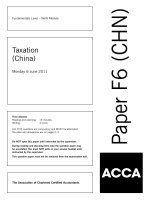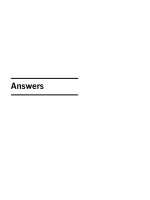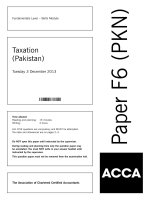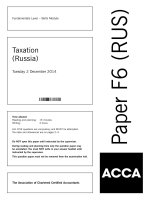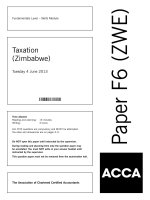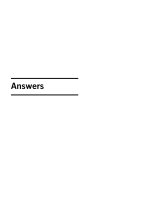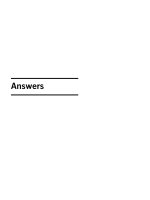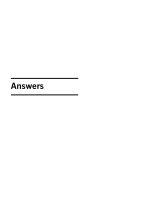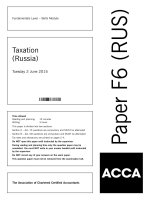ACCA f6 taxation zimbabwe 2011 dec question
Bạn đang xem bản rút gọn của tài liệu. Xem và tải ngay bản đầy đủ của tài liệu tại đây (136.07 KB, 17 trang )
Taxation
(Zimbabwe)
Tuesday 6 December 2011
Time allowed
Reading and planning:
Writing:
15 minutes
3 hours
ALL FIVE questions are compulsory and MUST be attempted.
Tax rates and allowances are on pages 2–4.
Do NOT open this paper until instructed by the supervisor.
During reading and planning time only the question paper may
be annotated. You must NOT write in your answer booklet until
instructed by the supervisor.
This question paper must not be removed from the examination hall.
The Association of Chartered Certified Accountants
Paper F6 (ZWE)
Fundamentals Level – Skills Module
SUPPLEMENTARY INSTRUCTIONS
1.
2.
3.
Calculations and workings need only be made to the nearest US$1, unless directed otherwise.
All apportionments should be made to the nearest month.
All workings should be shown.
TAX RATES AND ALLOWANCES
The following tax rates and allowances are to be used when answering the questions:
Rates – Individuals
Year ended 31 December 2010
Taxable
income band
US$
Up to 1 980
1 981 to 6 000
6 001 to 12 000
12 001 to 18 000
18 001 and over
Rate
of tax
%
0
20
25
30
35
Amount
within band
US$
1 980
4 020
6 000
6 000
Cumulative income
tax liability
US$
0
804
2 304
4 104
NB. The AIDS levy of 3% of income tax payable, less credits remains in place.
Allowable deductions year ended 31 December 2010
Pension fund contribution ceilings
2010
US$
(a) In relation to employers: in respect of each member
5 400
(b) In relation to employees: by each member of a pension fund
5 400
(c) In relation to each contributor to a retirement annuity fund or funds
5 400
(d) National Social Security:
3% of gross salary
Aggregate maximum contributions to all above per employee per year
5 400
Credits year ended 31 December 2010
2010
US$
900*
900*
50%
50%
Disabled/blind person
Elderly person (55 years and over)
Medical aid society contributions
Medical expenses
* The amount is reduced proportionately, if the period of assessment is less than a full tax year.
Deemed benefits year ended 31 December 2010
Motor vehicles
2010
US$
1 800
2 400
3 600
4 800
Up to 1500cc
1501 to 2000cc
2001 to 3000cc
3001 and above
2
Loans
The deemed benefit per annum is calculated at a rate of LIBOR +5% of the loan amount
advanced.
Value added tax (VAT)
Standard rate
15%
Capital allowances
%
25
25
Special initial allowance (SIA)
Accelerated wear and tear
Wear and tear:
Industrial buildings
Farm buildings
Commercial buildings
5
5
2·5
Motor vehicles
Movable assets in general
20
10
Tax rates
Year ended 31 December 2010
%
Companies
Income Tax
Basic rate
AIDS levy
25
3
Individuals
Income Tax
Income from trade or investment
AIDS levy
25
3
3
[P.T.O.
Capital gains tax
%
On marketable securities
20
Disposal of listed marketable securities acquired after 1 February 2009 1% of gross proceeds
Disposal of specified assets acquired prior to 1 February 2009
– Sold prior to 1 February 2009
20% of gain
– Sold after 1 February 2009
5% of gross proceeds
On principal private residence where the seller is over 55 years
0
On other immovable property acquired on or after 1 February 2009
20% of gain
Inflation allowance
2·5
Capital gains withholding tax on sale proceeds
Immovable property
Marketable securities (Listed) before 1 February 2009
Marketable securities (Unlisted)
Note: the withholding tax is not final on the seller. Actual liability is assessed
in terms of the Capital Gains Tax Act.
15
5
5
Withholding taxes
On dividends distributed by a Zimbabwean resident company to resident shareholders
other than companies and to non-resident shareholders:
By a company listed on the Zimbabwe Stock Exchange
By any other company
Informal traders
Foreign dividends
10
15
10
20
Non-residents’ tax
On interest
On certain fees and remittances
On royalties
nil
15
15
Residents’ tax on interest
From building societies
From other financial institutions (including discounted securities)
20
20
Elderly taxpayers (55 years and over)
The exemptions from income tax are as follows:
Rental income
Interest on deposits with a financial institution
Interest on discounted instruments
Income from the sale or disposal of marketable securities
Pension
Year ended 31 December 2010
US$
3 000
3 000
3 000
1 800
No limit
Income from the sale or disposal of a principal private residence is also exempted.
4
This is a blank page.
Question 1 begins on page 6.
5
[P.T.O.
ALL FIVE questions are compulsory and MUST be attempted
1
Gwen Brown has been working for the Institute of Internal Auditors (IIA) since its inception. At the beginning of
January 2010, she was seconded to the Public Services Salaries Bureau (PSSB) for a period of six months to
spearhead the restructuring exercise and the review of the system of internal control in that government department.
Terms of the PSSB engagement:
The IIA was to be paid a one off settlement of US$60 000 at the completion of the engagement as well as
reimbursement of the monthly operational expenses incurred based on submission of the relevant invoice on or before
the 25th of the month.
Gwen Brown was provided with the required human capital, office space and any other necessary resource to ensure
the successful execution of the engagement.
Gwen Brown’s only entitlements from the PSSB were the following monthly allowances:
US$
300
200
Fuel coupons
Overtime
Gwen Brown’s secondment to the PSSB did not in any way affect her salary and other entitlements from her employer,
the IIA, as these continued to accrue to her during the period of the secondment.
Gwen Brown’s earnings, entitlements and deductions from the IIA for the year ended 31 December 2010
US$
46 000
(15 000)
4 000
1 750
7 500
(72)
(4 528)
(2 500)
Salary
PAYE
Bonus
Fuel allowance
Entertainment allowance (75% used for IIA’s business)
NSSA contributions
Pension fund contributions by employee
Medical aid contributions (contributed by employee)
Additional information
(1) Gwen Brown stays in a fully furnished company house in Lakeview park which is located just outside the
Municipality of Harare. The cost of the furnishing in the house amounted to US$22 000. The IIA charges her a
nominal rent of US$150 per month.
(2) Gwen Brown makes use of a fully expensed company vehicle, an Isuzu double cab, engine capacity 3 300cc.
Her total mileage for the period to 31 October 2010 aggregated to 45 000 km, of which 25 000 km was
attributed to private use. In accordance with the policy on motor vehicles used by executive staff members, the
IIA offered Gwen Brown an opportunity to acquire the vehicle for US$5 200 on 1 November 2010. Gwen Brown
accepted the offer. The vehicle was purchased by the IIA four years previously for US$15 000 and the income
tax value at the date of sale was nil. The market value of the vehicle according to the Automobile Association of
Zimbabwe was US$10 000.
(3) On 1 July 2010 Gwen Brown successfully applied for a US$25 000 loan from her employer, the IIA. She used
US$15 000 to effect improvements on her private residence and the balance to pay for her post graduate studies.
Her employer charged her interest of 2% per annum on the loan. During this period the LIBOR was 1·5%.
(4) The IIA runs a scheme for its executive staff whereby it provides twice a year, free goods ranging from household
effects, clothing and groceries. During the year ended 31 December 2010, Gwen Brown received such goods
valued at US$9 000. The IIA had paid US$6 000 to acquire these goods.
(5) During the year ended 31 December 2010, Gwen Brown received a total of US$6 500 out of a matured
retirement annuity fund. She will receive the same amount yearly for a period of ten years. ZIMRA had disallowed
her a total of US$8 300 over the years as a deduction from her contributions to that fund.
6
(6) On 1 October 2010, Gwen Brown commenced part-time lecturing in Auditing at a local private college. She is
paid weekly for her services and the total amount received for the three months ended 31 December 2010 was
US$5 000. The amount was received gross as the private college is not registered with ZIMRA.
Gwen Brown’s other non employment related income received during the year ended 31 December 2010
US$
30 000
13 000
10 000
–––––––
53 000
–––––––
–––––––
Gross royalties received for her Auditing text book
Gross local company dividends (Unquoted shares)
Interest from local financial institutions
Required:
(a) Briefly explain the tax treatment, and calculate the taxable amounts for Gwen Brown, in respect of the
following:
(i)
The employment benefits stated in the additional information (1) to (4);
(6 marks)
(ii) The lump sum receipt of US$6 500 from the matured retirement annuity fund mentioned in the
additional information (5).
(1 mark)
(b) (i)
State the Public Services Salaries Bureau’s tax obligation when making the disbursement of US$60 000
to the Institute of Internal Auditors;
(2 marks)
(ii) Outline ZIMRA’s PAYE requirements which have been breached by the private college mentioned in the
additional information (6) and state the remedies at ZIMRA’s disposal.
(3 marks)
(c) Calculate Gwen Brown’s taxable income and tax payable for the year ended 31 December 2010 in respect
of all the income streams that accrued to her.
(13 marks)
(25 marks)
7
[P.T.O.
2
Solar Tech Enterprises (Private) Limited (STE) was incorporated in 2009 and commenced business operations on
1 January 2010, specialising in the manufacturing and distribution of solar panels, solar lights and solar powered
related products. STE’s head office and business premises are situated in Harare.
On 30 June 2009, STE had successfully applied for a two-year loan of US$750 000 with an interest rate of 15%
p.a. from a leading local financial institution. The loan was applied as follows:
US$
100 000
250 000
300 000
70 000
––––––––
720 000
30 000
––––––––
750 000
––––––––
––––––––
Showroom construction at Dande, a designated growth point
Procurement of the plant and machinery
Procurement of raw materials
Procurement of commercial vehicles
Total amount applied during the year ended 31 December 2009
Amount applied towards 2010 consultancy fee
Total
STE’s fixed asset register as at 31 December 2010 is as follows:
Head office building
Factory building
Furniture and fittings
4 Passenger vehicles
Total
Cost
US$
150 000
120 000
65 000
80 000
––––––––
415 000
––––––––
––––––––
Depreciation
US$
3 750
6 000
6 500
16 000
–––––––
32 250
–––––––
–––––––
Net book value
US$
146 250
114 000
58 500
64 000
––––––––
382 750
––––––––
––––––––
Note
The fixed assets procured using the loan were not included in the fixed asset register and neither was the expenditure
on raw material procurement recorded in STE’s books. These assets were first brought into use on 1 January 2010.
8
STE’s statement of comprehensive income for the year ended 31 December 2010 is as follows:
Note
US$
Turnover
Cost of sales
Gross profit
Add other operating income:
Bank interest
Sales commission
VAT refund
Less operating expenses:
Staff welfare
Repairs and maintenance
Insurance
Depreciation
Advertising and marketing
Printing and stationery
Utility costs
Motor vehicle expenses
Industrial research and development
Operating licence
Interest
General
Net profit before tax
Corporate tax paid
15 000
40 000
11 000
––––––––
1
2
3
4
5
6
7
8
9
Net profit for the year
661 200
45 000
22 000
32 250
203 800
7 120
32 700
78 600
33 300
25 000
183 750
57 900
––––––––
US$
4 834 500
(796 338)
––––––––––
4 038 162
66 000
––––––––––
4 104 162
(1 382 620)
––––––––––
2 721 542
(244 625)
––––––––––
2 476 917
––––––––––
––––––––––
Notes
1
Staff welfare:
US$
480 000
30 000
12 000
112 850
5 000
7 350
14 000
––––––––
661 200
––––––––
––––––––
Salaries and wages
Consultancy fee
Staff training
NSSA and pension contributions (80 employees)
Penalty for late PAYE
Staff end of year party
Initial payroll software licence
The consultancy fee was paid to a Botswana company, Solar Works, which seconded an expatriate who was
engaged from 2 January 2010 to 31 May 2010 on the basis of a temporary work permit. The expatriate was
also tasked with test running the plant and machinery. The consultancy fee was funded from the loan balance.
9
[P.T.O.
2
Advertising and marketing:
Advertising and promotion of solar products in foreign markets
Local market research, advertising and trade fares
Space rental at the Harare Exhibition showground
Solar magazine launch
Marketing director’s family and friends entertainment
3
Utility costs:
Electricity and water charges
Water reconnection
Installation of the solar panels for the Dande show room
4
US$
85 000
79 000
26 000
10 000
3 800
––––––––
203 800
––––––––
––––––––
US$
7 460
11 600
13 640
–––––––
32 700
–––––––
–––––––
Motor vehicle expenses:
US$
33 000
15 600
30 000
–––––––
78 600
–––––––
–––––––
Fuel and vehicle servicing
Insurance and licences
Vehicle tracking equipment
5
The total amount was contributed to SIRDC towards the research on solar powered cookers, heaters and
refrigerators. STE intends to broaden its product range by including these solar items in the near future.
6
The total amount was paid to the Municipality of Harare as the initial operating licence for the factory.
7
Interest:
US$
15 000
56 250
112 500
––––––––
183 750
––––––––
––––––––
2% loan establishment fee
2009 interest paid
2010 interest paid
8
General:
Legal fees for the Harare show ground lease agreement
Architect’s fees for the factory building plan
Staff teas and refreshments
Office cleaning
Donation to a political party
9
US$
6 000
10 000
28 600
10 300
3 000
––––––––
57 900
––––––––
––––––––
The amount refers to the provisional tax paid during the course of the year. The accountant had projected the
taxable income for the year ended 31 December 2010 as US$950 000.
10
Required:
(a) Explain how the following should be accounted for tax purposes:
(i)
The expenses incurred during the year ended 31 December 2009, prior to the commencement of
trading;
(2 marks)
(ii) The consultancy fee detailed in note 1;
(2 marks)
(iii) The interest paid detailed in note 7.
(6 marks)
(b) (i)
Calculate the maximum capital allowances claimable by Solar Tech Enterprises (Private) Limited for the
year ended 31 December 2010;
(9 marks)
(ii) Calculate the taxable income and the tax payable by Solar Tech Enterprises (Private) Limited for the year
ended 31 December 2010.
(11 marks)
(30 marks)
11
[P.T.O.
3
Chipo Chitanda is a 58-year-old widow and resides at her farm in Mvurwi in Mashonaland Central province. Due to
viability challenges, Chipo Chitanda decided to dispose of her farm to pursue other business ventures in Harare. The
farm was acquired on 1 March 2009.
On 30 September 2010, Chipo Chitanda accepted an offer of US$1 310 000 for her farm, broken down as follows:
US$
150 000
380 000
130 000
102 000
98 000
43 000
59 000
17 000
209 000
––––––––––
1 188 000
––––––––––
––––––––––
Land
Farmhouse
Staff houses
Tobacco barns
Irrigation equipment
Water pumps
Tractors
Grinding mill
Storage building
The full amount was paid through her attorney on 15 October 2010. The attributable legal and all ancillary costs in
connection with this transaction amounted to US$15 000. Chipo Chitanda used part of her sale proceeds to buy a
townhouse to use as her new personal residence at a cost of US$500 000. She signed the sale agreement for her
new home on 15 December 2010.
Chipo Chitanda’s extract from her farm fixed asset register is as follows:
Cost
US$
100 000
200 000
90 000
50 000
45 000
20 000
23 000
10 000
111 000
Land
Farmhouse
Staff houses
Tobacco barns
Irrigation equipment
Water pumps
Tractors
Grinding mill
Storage building
Income tax value
US$
100 000
200 000
45 000
25 000
22 500
10 000
11 500
5 000
55 500
Required:
(a) From the information given, list the amounts to be included in Chipo Chitanda’s gross capital amount for
capital gains tax purposes, showing clearly any amounts which are exempt. Give brief explanations for your
answer.
(3 marks)
(b) (i)
Calculate Chipo Chitanda’s taxable income and tax payable for the year ended 31 December 2010;
(5 marks)
(ii) Calculate Chipo Chitanda’s capital gain and tax payable for the year ended 31 December 2010;
(6 marks)
(iii) State with reasons whether roll over relief is applicable.
(1 mark)
(15 marks)
12
This is a blank page.
Question 4 begins on page 14.
13
[P.T.O.
4
William Mark is an accomplished cattle rancher and dairy farmer in the Nyamandhlovu area in the Matabeleland
region.
William Mark has always maintained his livestock at the assessed carrying capacity of his land (ACCL) which is 500
herd but during the year ended 31 December 2010, he was forced to sell 60% of his herd due to the terrible drought
that year. However, he intends to restock his herd in the coming agricultural season as the Meteorological Department
has forecasted a normal plus rainy season. The Nyamandhlovu area was designated a drought-stricken area at the
beginning of 2010 by the Minister.
His livestock as at 1 January 2010 was as follows:
Bulls
Cows
Oxen
Heifers
Tollies
Calves
Quantity
10
230
170
45
30
15
––––
500
––––
––––
Approved valuation (US$)
PPV
200
FSV
100
FSV
80
FSV
50
FSV
40
FSV
20
Livestock value (US$)
2 000
23 000
13 600
2 250
1 200
300
–––––––
42 350
–––––––
–––––––
Livestock activities during the year ended 31 December 2010:
2 bulls were stolen
180 cows and 120 oxen were sold due to the stress of drought
20 cows and 30 oxen were sold to the Cold Storage Company (CSC)
20 heifers and 10 tollies were regraded to cows and oxen respectively
10 calves were graded to heifers and 5 to tollies
25 calves were born during the year
Fixed asset register as at 1 January 2010:
Year acquired/constructed
Security fence
Farmhouse
Staff housing (3 units)
Tractor
Boreholes
Deep tanks
Commercial vehicle
Passenger vehicle
3 wells
2002
2002
2010
2005
2002
2009
2002
2007
2010
Cost
US$
10 000
120 000
60 000
18 000
7 000
32 000
13 000
20 000
9 000
Net book value
US$
10 000
120 000
60 000
nil
7 000
30 400
nil
12 000
9 000
William Mark’s policy on fixed assets has always been to claim the maximum capital allowances possible in any given
year.
William Mark’s income and expenditure details from his farming operations for the year ended 31 December 2010:
Income
Drought induced sales
CSC sales
Profit on sale of the commercial vehicle
Expenditure
Stock feed
Deeping chemicals and vaccines
Wages
Livestock purchases
Note
US$
1
129 000
87 000
15 000
2
14
19
12
22
45
000
500
700
000
Notes
1
The commercial vehicle was sold at the market value of US$15 000 during the year.
2
William Mark signed an agreement with a Manicaland farmer for the purchase of 300 cattle for US$45 000 on
21 December 2010 in order to restock his herd which was depleted due to the drought-induced sales. The terms
of the agreement were that the payment was due on signing the agreement but the cattle will be delivered
14 days thereafter during which time all the legal formalities would have been completed.
Required:
(a) Explain and calculate the tax reliefs available to William Mark for the year ended 31 December 2010 in
connection with the drought.
(4 marks)
(b) (i)
Calculate the livestock closing stock value as at 31 December 2010;
(3 marks)
(ii) Calculate the minimum taxable income and tax payable by William Mark for the year ended
31 December 2010.
(8 marks)
(15 marks)
15
[P.T.O.
5
Farai Mambo, a VAT registered trader, operates his business within a department store in the CBD of Harare. He
specialises in the retail of a wide range of exclusive furnishings and accessories for the home.
For the past two years in a row, Farai Mambo’s sales have been on the decline due to the availability of cheaper
counterfeit products on the market. During the year ended 31 December 2010, due to the unabated mismatch
between his cash inflows and outflows, Farai Mambo decided to wind up his business operations.
Included in Farai Mambo’s fixed assets are the following vehicles allocated to his three senior staff members:
Toyota Corolla engine capacity, 1300cc
Toyota Harrier engine capacity, 2400cc
Nissan truck, engine capacity, 3000cc
Farai Mambo makes use of a Toyota Prado vehicle with an engine capacity of 3300cc.
In view of Farai Mambo’s cash flow constraints, he negotiated with his senior employees to take over the allocated
vehicles at reduced prices to compensate for unsettled salaries. All the three staff vehicles were purchased in 2009.
The vehicle sale agreements were signed on 31 October 2010, the date at which Farai Mambo closed his business
operations.
Details of the vehicle sale agreements:
Toyota Corolla
Toyota Harrier
Nissan truck
Cost price
(US$)
8 000
13 000
16 500
Agreed selling
price (US$)
3 500
7 800
9 200
Market value
(US$)
7 500
12 000
14 300
Farai Mambo has always claimed the maximum capital allowances available for his acquired fixed assets.
The credits and debits to Farai Mambo’s Income statement for the year ended 31 December 2010 are as follows:
Notes
Credits (VAT inclusive as appropriate)
Sales
Commission received on consignment stock
Purchases returns
Insurance claim received
Debits (VAT inclusive as appropriate)
Purchases
Rent
Motor vehicle expenses
General office expenses
Staff expenses
Repairs and maintenance
Interest paid on bank overdraft
(i)
(ii)
(iii)
US$
53
10
4
8
700
000
500
000
24
15
8
3
35
6
4
900
000
300
700
000
000
200
Notes
(i)
The insurance claim refers to the compensation received for Farai Mambo’s laptop which was stolen from his
office during the year. 30% of the laptop is used for private purposes.
(ii) 20% of the amount was paid to unregistered tax operators.
(iii) Included in the amount is US$1 300 which was paid for the repairs effected to Farai Mambo’s private residential
property.
16
Required:
(a) (i)
List ANY THREE of Farai Mambo’s general obligations to ZIMRA as a registered operator;
(ii) List the TWO specific obligations of Farai to ZIMRA as a result of his cessation of trade;
(3 marks)
(2 marks)
(iii) Explain the tax implications of the negotiated settlement between Farai Mambo and his senior
employees.
Note: calculations are NOT required in part (a).
(b) (i)
(2 marks)
Calculate the output tax in connection with the motoring benefits for the year ended 31 December
2010;
(1 mark)
(ii) Calculate Farai Mambo’s VAT position for the year ended 31 December 2010. Where VAT is not
chargeable or claimable, indicate this by the use of a zero (0).
(7 marks)
(15 marks)
End of Question Paper
17
